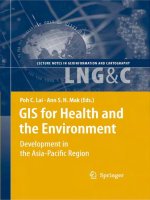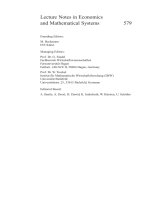- Trang chủ >>
- Khoa Học Tự Nhiên >>
- Vật lý
Lecture notes in geoinformation and cartography
Bạn đang xem bản rút gọn của tài liệu. Xem và tải ngay bản đầy đủ của tài liệu tại đây (30.98 MB, 472 trang )
Lecture Notes in Geoinformation and Cartography
Series Editors: William Cartwright, Georg Gartner,
Liqiu Meng, Michael P. Peterson
Qiming Zhou · Brian Lees · Guo-an Tang (Eds.)
Advances in Digital Terrain
Analysis
Editors
Prof. Qiming Zhou
Hong Kong Baptist University
Department of Geography
Kowlon Tong
Kowlooon
Hong Kong/PR China
Prof. Brian Lees
The University of New South
Wales at ADFA
ACT 2600
Australia
Prof. Guo-an Tang
Nanjing Normal University
Key Laboratory of Virtual
Geographic Environment
210046 Nanjing
China, People’s Republic
ISBN: 978-3-540-77799-1
e-ISBN: 978-3-540-77800-4
Lecture Notes in Geoinformation and Cartography ISSN: 1863-2246
Library of Congress Control Number: 2008921722
c 2008 Springer-Verlag Berlin Heidelberg
This work is subject to copyright. All rights are reserved, whether the whole or part of the material is
concerned, specifically the rights of translation, reprinting, reuse of illustrations, recitation, broadcasting,
reproduction on microfilm or in any other way, and storage in data banks. Duplication of this publication
or parts thereof is permitted only under the provisions of the German Copyright Law of September 9,
1965, in its current version, and permission for use must always be obtained from Springer. Violations are
liable to prosecution under the German Copyright Law.
The use of general descriptive names, registered names, trademarks, etc. in this publication does not imply,
even in the absence of a specific statement, that such names are exempt from the relevant protective laws
and regulations and therefore free for general use.
Cover design: deblik, Berlin
Printed on acid-free paper
9 8 7 6 5 4 3 2 1
springer.com
Preface
The chapters in this book mostly started as presentations at the Terrain
Analysis and Digital Terrain Modelling conference hosted by Nanjing
Normal University in November 2006. As far as I am aware this was the
first international conference devoted specifically to this area of research,
and since it was also my first visit to China it was an exciting and unique
experience for me. The participants ranged from leaders in the field
discussing visions and challenges for the future to students grappling with
the possibilities and exploring new directions. These papers are a selection
of the many presentations at the conference and give some indication of
the breadth of research on show at the meeting.
Digital terrain analysis has moved beyond a research tool into routine
application, such as determination of catchment areas and flow pathways
in hydrological analysis, supporting soil mapping through spatial
prediction and the definition of landform elements, and the use of slope
and other attributes for land capability analysis. But there are still many
areas of active research refining these methods or exploring new
approaches, as this book shows.
One recent development explored in several of the papers in this book is
the availability of global or near-global terrain data in several forms,
GTOPO-30 and SRTM 3 second data being the most significant. Reliable
global topographic data opens the doors for truly global analysis,
consistent analysis on different continents and the generation of collective
experience that is transforming the field of geomorphometry into a robust
science.
Another theme reflected in these papers is the increasing sophistication
in our understanding of issues related to scale, accuracy, uncertainty and
error propagation in digital terrain analysis. As these methods are
increasingly used to support important decisions, information on
uncertainty becomes vital for the rational use of predictions. There is still
some way to go before we have tools for estimating and representing
uncertainties that meet the needs of our user community.
Other papers demonstrate the continued demand for improved methods
to classify and segment the land surface into useful units for land
management or mapping; showcase innovations in representing and
characterising the land surface; highlight a growing focus on processes
rather than statistical correlations for understanding the earth’s surface;
and exemplify the ongoing development and testing of new algorithms
addressing deficiencies in quality and efficiency of existing methods.
vi
Preface
At the Nanjing conference, I was astonished by the number of students
from China and elsewhere training in this research area and by the variety
and innovation of their work. I was also impressed by their probing
questions and contributions to the discussions. The conference provided an
opportunity to renew some old friendships, make new friends and meet for
the first time some of the people whose names I knew from their published
papers. I greatly enjoyed the interaction with so many disciples in the field
of terrain analysis and consider myself fortunate to have had the
opportunity to participate in this meeting. I am hopeful of many more
stimulating and rewarding meetings and discussions as part of the TADTM
initiative in the coming years.
Dr John Gallant
CSIRO Land and Water, November 2007
Contents
List of Contributors
xi
Introduction
1
ZHOU Qiming, Brian G. LEES and TANG Guo-an
Advances in Digital Terrain Analysis: The TADTM Initiative
3
Section 1: Digital Representation for Terrain Analysis
11
George Ch. MILIARESIS
Quantification of Terrain Processes
13
Peter A. SHARY
Models of Topography
29
LI Zhilin
Multi-Scale Digital Terrain Modelling and Analysis
59
ZHAO Xuesheng, BAI Jianjun and CHEN Jun
A Seamless and Adaptive LOD Model of the Global Terrain
Based on the QTM
85
Section 2: Morphological Terrain Analysis
105
TANG Guo-an and LI Fayuan
Landform Classification of the Loess Plateau Based on Slope
Spectrum from Grid DEMs
107
Josef STROBL
Segmentation-based Terrain Classification
125
Lucian D. DRĂGUğ and Thomas BLASCHKE
Terrain Segmentation and Classification using SRTM Data
141
viii
Contents
LU Huaxing
Modelling Terrain Complexity
159
LIU Aili
DEM-based Analysis of Local Relief
177
YANG Qinke, David JUPP, LI Rui and LIANG Wei
Re-Scaling Lower Resolution Slope by Histogram Matching
193
Section 3: Hydrological Terrain Analysis
211
John P. WILSON, Graeme AGGETT, DENG Yongxin and
Christine S. LAM
Water in the Landscape: A Review of Contemporary Flow
Routing Algorithms
Petter PILESJÖ
An Integrated Raster-TIN Surface Flow Algorithm
TIAN Yuan, WU Lun, GAO Yong, WANG Daming and
ZHANG Yi
DEM-based Modelling and Simulation of Modern Landform
Evolution of Loess
213
237
257
Section 4: Uncertainty in Terrain Analysis
277
ZHOU Qiming and LIU Xuejun
Assessing Uncertainties in Derived Slope and Aspect
from a Grid DEM
279
LIU Xuejun and BIAN Lu
Accuracy Assessment of DEM Slope Algorithms Related to
Spatial Autocorrelation of DEM Errors
307
DENG Fengdong, WANG Lili, ZHUO Jing and LIU Anlin
Modelling Slope Field Uncertainty Derived From DEM
in the Loess Plateau
323
Contents
ZHU A-Xing, James E. BURT, Michael SMITH, WANG Rongxun
and GAO Jing
The Impact of Neighbourhood Size on Terrain Derivatives
and Digital Soil Mapping
ix
333
Brian G. LEES, HUANG Zhi, Kimberley VAN NIEL
and Shawn W. LAFFAN
The Impact of DEM Error on Predictive Vegetation Mapping
349
Section 5: Applications of Terrain Analysis
363
Igor V. FLORINSKY
Global Lineaments: Application of Digital Terrain Modelling
365
John B. LINDSAY and James J. ROTHWELL
Modelling Channelling and Deflection of Wind by Topography
383
ZHANG Ting, LI Jun, WANG Chun and ZHAN Lei
Spatial Correlation of Topographic Attributes in Loess Plateau
407
YANG Xin and XIAO Chenchao
Terrain-based Revision of an Air Temperature Model
in Mountain Areas
425
James R.F. BARRINGER, Allan E. HEWITT, Ian H. LYNN
and Jochen SCHMIDT
National Mapping of Landform Elements in Support of S-Map,
A New Zealand Soils Database
443
Concluding Remarks
459
Brian G. LEES
Progress in Digital Terrain Analysis
461
List of Contributors
Graeme AGGETT, Riverside Technology Inc., 2290 East Prospect Road,
Suite 1, Fort Collins, Colorado CO 80525
E-mail:
BAI Jianjun, Department of Surveying, China University of Mining and
Technology (Beijing), D11, Xueyuan Road, Beijing 100083, P.R.
China
James R. F. BARRINGER, Landcare Research, PO Box 40, Lincoln
7640, New Zealand, Email:
BIAN Lu, Key Laboratory of Virtual Geographic Environment, Nanjing
Normal University, Ministry of Education, Nanjing, Jiangsu
210046, P.R. China
Thomas BLASCHKE, Researchstudio iSPACE, ARC Austrian Research
Centers, Leopoldskronstr. 30, 5020 Salzburg, Austria
James E. BURT, Department of Geography, University of WisconsinMadison, 550 N. Park St, Madison WI 53706, USA
CHEN Jun, National Geometric Centre of China, No.1 Baishengcun,
Zizhuyuan, Beijing 10004, P.R. China
Email: ,
DENG Fengdong, Shaanxi Remote Sensing Information Centre for
Agriculture, Email:
DENG Yongxin, Department of Geography, Western Illinois University,
Macomb, IL 61455, E-mail:
Lucian D. DRĂGUğ, GIS-Centre for Geoinformatics, Salzburg
University, Schillerstr. 30, 5020 Salzburg, Austria
Email:
Igor V. FLORINSKY, Institute of Mathematical Problems of Biology,
Russian Academy of Sciences, Pushchino, Moscow Region,
142290, Russia, Email:
GAO Jing, Department of Geography, University of Wisconsin-Madison,
550 N. Park St. Madison WI 53706, USA
Email:
GAO Yong, Institute of RS and GIS, Peking University, Beijing, 100871,
P.R. China
Allan E. HEWITT, Landcare Research, PO Box 40, Lincoln 7640, New
Zealand
HUANG Zhi, The Australian Government Department of Environment
and Water Resources, Email:
xii
List of Contributors
David JUPP, CSIRO Marine and Atmospheric Research, CS Christian
Building, CSIRO Labs, Clunies Ross St., Black Mountain ACT,
2601, Australia
Shawn W. LAFFAN, School of Biological, Earth and Environmental
Sciences, University of New South Wales, Australia
Email:
Christine S. LAM, GIS Research Laboratory, Department of Geography,
University of Southern California, Los Angeles, CA 90089-0255,
Email:
Brian G. LEES, The University of New South Wales at ADFA, Canberra,
ACT 2600, Australia, E-mail:
LI Fayuan, Key Laboratory of Virtual Geographic Environment, Nanjing
Normal University, Ministry of Education, Nanjing, Jiangsu,
210046, P.R. China
LI Jun, Key Laboratory of Virtual Geographic Environment, Nanjing
Normal University, Ministry of Education, Nanjing, 210046, P.R.
China
LI Rui, Northwest University, No 229, Northern Taibai Road, Xi’an
710069, P.R. China
LI Wei, Northwest University, No 229, Northern Taibai Road, Xi’an
710069, P.R. China
LI Zhilin, Dept. of Land Surveying and Geo-Informatics, The Hong Kong
Polytechnic University, Hong Kong, Email:
LIANG Wei, Northwest University, No 229, Northern Taibai Road, Xi’an
710069, P.R. China
John B. LINDSAY, Uplands Environments Research Unit (UpERU),
School of Environment and Development, The University of
Manchester, Oxford Road, Manchester, M13 9PL, UK,
Email:
LIU Aili, School of Remote Sensing, Nanjing University of Information
Science & Technology, Street No.114 Pancheng New, Nanjing,
Jiangsu 210044, P. R. China. Email:
LIU Anlin, Shaanxi Remote Sensing Information Centre for Agriculture,
Email:
LIU Xuejun, Key Laboratory of Virtual Geographic Environment, Nanjing
Normal University, Ministry of Education, Nanjing, 210046, P.R.
China
LU Huaxing, Key Laboratory of Virtual Geographic Environment,
Ministry of Education, Nanjing Normal University, No.1 WenYuan
Road , Nanjing, Jiangsu, 210046, P.R. China
Email:
List of Contributors
xiii
Ian H. LYNN, Landcare Research, PO Box 40, Lincoln 7640, New
Zealand
George Ch. MILIARESIS, Department of Geology, University of Patras,
Rion 26504, Greece, Email:
Petter PILESJÖ, Lund University GIS Centre, Lund University,
Solvegatan 12, SE-223 62 Lund, Sweden
Email:
James J. ROTHWELL, Department of Environmental & Geographical
Sciences, Manchester Metropolitan University, Chester Street,
Manchester, M1 5GD, UK
Jochen SCHMIDT, National Institute of Water and Atmosphere (NIWA),
PO Box 8602, Christchurch, New Zealand
Peter A. SHARY, Institute of Physical, Chemical and Biological Problems
of Soil Science, RAS, 142290 Institutskaya Street Bldg. 2,
Poushchino, Moscow Region, Russia
Email:
Michael SMITH, Department of Geography, University of WisconsinMadison, 550 N. Park St., Madison WI, 53706, USA
Josef STROBL, Centre for Geoinformatics, Salzburg University,
Hellbrunnerstrasse 34, 5020 Salzburg, Austria
Email:
TANG Guo-an, Key Laboratory of Virtual Geographic Environment,
Nanjing Normal University, Ministry of Education, Nanjing,
210046, P.R. China
TIAN Yuan, Institute of RS and GIS, Peking University, Beijing, 100871,
P.R. China, Email:
Kimberley VAN NIEL, School of Earth and Geographical Sciences,
University of Western Australia, 35 Stirling Hwy, Crawley WA
6009, Australia, Email:
WANG Chun, Key Laboratory of Virtual Geographic Environment,
Nanjing Normal University, Ministry of Education, Nanjing,
210046, P.R. China
WANG Daming, Institute of RS and GIS, Peking University, Beijing,
100871, P.R. China
WANG Lili, Shaanxi City and Country Planning & Design Research
Institute
WANG Rongxun, Department of Geography, University of WisconsinMadison, 550 N. Park St, Madison WI, 53706, USA
John P. WILSON, GIS Research Laboratory, Department of Geography,
University of Southern California, Los Angeles, CA 90089-0255,
Email:
This page intentionally blank
xiv
List of Contributors
WU Lun, Institute of RS and GIS, Peking University, Beijing, 100871,
P.R. China
XIAO Chenchao, Institute of Remote Sensing and GIS, Peking University,
Beijing 100871, P.R. China, Email:
YANG Qinke, Northwest University, No 229, Northern Taibai Road,
Xi’an 710069, P.R. China, Email:
YANG Xin, Key Laboratory of Virtual Geographic Environment, Nanjing
Normal University, Ministry of Education, Street No.1 Wen Yuan,
Nanjing, Jiangsu 210046, P. R. China, Email:
ZHAN Lei, Key Laboratory of Virtual Geographic Environment, Nanjing
Normal University, Ministry of Education, Nanjing, 210046, P.R.
China
ZHANG Ting, Key Laboratory of Virtual Geographic Environment,
Nanjing Normal University, Ministry of Education, 210046,
Nanjing, P.R. China, Email:
ZHANG Yi, Institute of RS and GIS, Peking University, Beijing, 100871,
P.R. China
ZHAO Xuesheng, Department of Surveying, China University of Mining
and Technology (Beijing), D11, Xueyuan Road, Beijing 100083,
P.R. China, Email:
ZHOU Qiming, Department of Geography, Hong Kong Baptist
University, Kowloon Tong, Kowloon, Hong Kong
Email:
ZHU A-Xing, State Key Laboratory of Resources and Environmental
Information System, Institute of Geographical Sciences and Natural
Resources Research, Chinese Academy of Sciences, Beijing
100101, P.R. China
ZHUO Jing, Shaanxi Remote Sensing Information Centre for Agriculture,
Email:
Introduction
Advances in Digital Terrain Analysis:
The TADTM Initiative
ZHOU Qiming, Brian G. LEES and TANG Guo-an
Background
Digital terrain modelling has been one of the most active research and application fields in geo-spatial information science and technology. Using
the techniques of computer graphics, the land surface, or terrain surface,
can be represented digitally using large volumes of regularly or irregularly
distributed sample points, instead of solely relying on the traditional contours or other cartographic symbolism. The term digital terrain model
(DTM) is now widely recognized as the digital representation of the terrain
surface for a given geographical region.
Compared to traditional contour maps, Li et al. (2005) outlined the specific features of a DTM as:
1. A variety of representation forms,
2. No accuracy loss of data over time,
3. Greater feasibility of automation and real-time processing, and
4. Easier multi-scale representation.
Despite its obvious advantages as listed above, the effective use of
DTMs, however, requires more effort than the interpretation of traditional
paper maps. Just as terrain information extraction from a contour map requires the techniques of map reading, interpretation, and measurement, deriving terrain features and measurements from a DEM also demands information extraction methods and techniques based on digital
representation of the terrain. This leads to the focus of this volume – digital terrain analysis (DTA).
If we use the term digital elevation model (DEM) to refer to terrain
models with elevation information only, while the term digital terrain
model (DTM) refers to a much broader concept of terrain representation,
including terrain parameters such as slope and aspect, terrain features such
as ridges and valleys and other geographical/environmental characteristics,
DTA specifies the process that transforms DEMs to DTMs, using the principles and knowledge of geography, or other application fields (Figure 1).
This process was also previously termed “DTM interpretation” (Hutchinson
and Gallant 1999).
4
ZHOU Qiming, Brian G. LEES and TANG Guo-an
slope
aspect
DEM
DTA
DTM
curvature
……
catchment
Figure 1. DEM, DTM and DTA.
Development of Computer-aided Terrain Analysis
Computer-aided terrain analysis is not a new concept. It has been an active
field of study for some years and has attracted effort from many researchers including geographers, surveyors, engineers, and computer scientists.
However, due to lack of communication across various disciplines, the efforts seem to be quite isolated and have mainly focused on problems
within individual application fields. For example, in the field of geomorphometry, the research focuses on the extraction of morphological features
of terrain and simulation of geomorphological processes (Miliaresis 2001).
In the field of hydrology, researchers concentrate on deriving quantitative
derivatives from DEMs for hydrological modelling (Band 1999), while in
the field of geo-sciences the statistical features of the terrain in a geographical region attract more attention (Davis 2002).
The different application fields share the basic principle of terrain analysis as they fundamentally deal with the same thing – extracting quantitative
derivatives from digital terrain data. Thus it is natural to expect the breakdown of the “communication barrier” between different interest groups so
that the technology can further advance for problem solving, which will
eventually deliver the benefits to everybody. In the past decades, there
have been some efforts to bring people in the field of terrain analysis together. The pioneering works of Moore et al. (1991) and others are mostly
focused on the hydrological applications (Beven and Moore 1991), but potential applications in the fields of geomorphology and biology were also
reviewed. Wilson and Gallant (2000) presented a collection of techniques,
methods, and applications of terrain analysis in the fields of hydrology,
geomorphology, ecology, and soil sciences. Though the majority of the
Advances in Digital Terrain Analysis: The TADTM Initiative
5
methods and applications were demonstrated through a dedicated software
tool – TAPES (Terrain Analysis Programs for the Environmental Sciences), comprehensive and in-depth discussions on principles and algorithms of digital terrain analysis were well covered.
Although the methodology and technology of DTA have been developed well with the rapid advances in geo-spatial information technology,
they remain for the most part in the research and development domain.
Driven by commercial motivations, today’s popular GIS software packages are more interested in DTM visualization and presentation, the quantitative analysis and information extraction from digital terrain data being
poorly supported. Even though more advanced and accurate algorithms
have already been developed in DTA for some years, their implementation
in commercial GIS software packages has been slow and seldom supported.
The poor implementation of DTA technology is largely due to the following reasons:
x Most DTA research is narrowly focused with assumptions and limitations that only apply to the local conditions.
x Quantitative models in many application fields such as geography,
geomorphology, ecology, and soil sciences are either poorly developed or too generous to be tested in real-world conditions.
x Lack of awareness of advanced technology in DTA has restricted
broader DTA applications.
x Lack of communications and inter-discipline collaborations results in
slower progress in the advance of DTA.
With the rapid growth of Geographical Information System (GIS) technology, particularly the establishment of high resolution digital elevation
models (DEM) at national level, the challenge is now focused on delivering justifiable socio-economical and environmental benefits, i.e. extracting
and presenting parameters and features inherent in the DEM for more direct use in applications. To make this possible, more collaborated interdiscipline effort is undoubtedly needed.
About the TADTM Initiative and the Symposium
In response to the above shortfalls, the Terrain Analysis and Digital Terrain Modelling (TADTM) initiative was proposed in early 2006 and overwhelmingly supported by workers in the DTA fields around the world. The
initiative proposed actions such as:
6
ZHOU Qiming, Brian G. LEES and TANG Guo-an
x Identifying research groups that had been active in research fields related to digital terrain analysis.
x Establishing communication platforms (or “access points”) such as
websites and mailing lists, so that regular exchange of ideas could be
conducted.
x Organizing an international workshop on digital terrain analysis.
x Publishing selected research papers in an edited volume or in journals.
x Establishing a workgroup on digital terrain analysis in related international communities.
One of the above actions was the organization of the International Symposium on Terrain Analysis and Digital Terrain Modelling, which was
held in Nanjing Normal University, Nanjing, China during 23–25 November 2006. The Symposium attempted to create a platform for better communications and scholarly exchange among researchers in the fields of terrain analysis, geomorphometry, environmental modelling, and
geographical information sciences. The Symposium comprises about 60
papers covering broad areas of terrain analysis and modelling, including:
x Feature extraction from DEM
x Terrain classification and spatial analysis
x Terrain modelling and DEM management
x Scales in digital terrain analysis
x Uncertainty in digital terrain analysis
x DTM and geomorphometry
x DTM and land cover modelling
x DTM-based soil-landscape modelling
x DTM-based environmental change modelling and simulation
x Urban DTM
Three keynote papers were presented by John WILSON on “From precipitation to streamflow: simulating the movement of water within landscapes”, George MILIARESIS on “Terrain modelling for specific geomorphologic processing”, and John GALLANT on “Multiscale methods in
terrain analysis”. Eight invited papers covering a wide range of topics were
also presented in plenary sessions by CHEN Jun, Josef STROBL, Peter
SHARY, TANG Guo-an, Petter PILESJÖ, ZHU A-xing, LI Zhilin and
Igor FLORINSKY. A panel discussion session was also organized to
stimulate free discussion between the audience and panellists. The Symposium was well received by over 100 participants including many young
scholars and postgraduate research students, who we believe will form the
backbone of the future DTA community.
Advances in Digital Terrain Analysis: The TADTM Initiative
7
About this Volume
This volume collects 23 contributions from papers presented in the
TADTM 2006 Symposium. The selected papers were first revised by the
contributors to meet the publication quality required for book chapters.
The manuscripts were then peer-reviewed by an international expert panel
and the authors were requested to revise and respond to the criticism and
comments raised by the reviewers before the contributions were presented
in their final form.
The contents of this volume are divided into five sections:
Section 1 “Digital Representation for Terrain Analysis” focuses on the
terrain data model and representation for DTA. From the point of view of
geomorphometry, Miliaresis provides a review of the research on quantitative models of terrain processes – the theoretical foundation of DTA. Similarly, Shary describes the mathematical foundations of the representation
of digital terrain models and terrain derivatives. Li addresses the issues related to the multi-scale representation of the terrain, which may have great
impact on the outcomes from DTA. For DTA at a global scale, Zhao et al.
propose a seamless and adaptive LOD (level of details) model of the
global terrain based on QTM (Quaternary Triangular Mesh).
Section 2 “Morphological Terrain Analysis” contains six chapters focusing on the extraction and interpretation of morphological features and
measurement of terrain. Tang and Li propose a statistical approach that
employs “slope spectrum” for landform classification in the Loess Plateau
of China. Strobl presents a review of the basic conceptual foundations for
segmentation in terrain classification. Also on terrain classification, Dragut
and Blaschke report on research that segments and classifies Shuttle Radar
Topography Mission (SRTM) data into specific landforms using objectoriented image analysis. As well as classification issues, new methods for
terrain description are also addressed in this section. Lu proposes the compound terrain complexity index (CTCI), which is made of four traditional
terrain morphological indices including total curvature, roughness, local
relief, and local standard deviation as a quantitative measurement of terrain
complexity. Liu proposes a method for extracting local relief from a 1-km
resolution DEM of China to investigate the large-scale geomorphological
features. Yang et al. describe an approach by slope histogram matching to
re-scale a coarser resolution slope histogram into the slope histogram at a
finer resolution, so that the statistical characteristics of the higherresolution DEM derivatives will be maintained to minimize the “slopereduction” effect.
8
ZHOU Qiming, Brian G. LEES and TANG Guo-an
Section 3 “Hydrological Terrain Analysis” addresses principles and algorithms of hydrological modelling with DTMs. Wilson et al. present a
comprehensive review of the advances in hydrological applications of
DTA with the emphasis on the simulation of the movement of water within
landscapes. Pilesjö reports a new algorithm that simulates the flow over a
surface defined by a grid DEM. For the study of soil erosion, especially in
the Loess Plateau of China, Tian et al. report the development of a modern
catchment landform evolution model (MCLEM) that describes and simulates the processes of tectonic elevation, weathering, hillslope, and fluvial
transportation.
Section 4 “Uncertainty in Terrain Analysis” comprises contributions focusing on the uncertainty and errors in DTA. Zhou and Liu analyse errors
in the derived slope and aspect from grid DEMs due to errors in data, algorithm selection, data properties such as precision, grid resolution and orientation, and terrain complexity. A data-independent assessment method is
proposed for more objective and accurate evaluation of DTA algorithms.
Liu and Bian analyse the impact of spatial autocorrelation of DEM data error, estimate the accuracy of selected slope algorithms accordingly, and
then design a Monte Carlo simulation experiment to validate the results.
Deng et al. study the uncertainty of derived slope field (i.e. farmland with
a steep slope) related to the scale of DEM data. On more application oriented studies, Zhu et al. examine the combined effect of DEM resolution
and neighbourhood size on computed terrain derivatives and its impact on
digital soil mapping, while Lees et al. analyse the impact of DEM error on
the derived indices, which in turn influence predictive vegetation mapping
for landuse and land cover classification.
Section 5 “Applications of Terrain Analysis” contains contributions that
report the newest developments in DTA applications. Florinsky examines
the hypothesis for the existence of hidden global linear (helical) structures,
which are tectonically and topographically expressed, using 18 topographic variables derived by DTA based on a 30-arc-minute grid DEM for
the entire surface of the Earth. Lindsay and Rothwell present and evaluate
a new index of exposure/sheltering to wind, the channelling/deflection index (CDI), which is capable of modelling channelling and deflection of
flowlines and shadowing of wind. Tested in 47 different loess landforms
represented by a DEM with 5 m resolution, Zhang et al. propose a spatial
correlation model for nine selected terrain attributes for deriving quantitative terrain parameters and landform recognition. Yang and Xiao show the
use of DTA for surface temperature estimation by constructing a terrain
reversed model, which estimates surface temperature by simulating insolation on each grid cell of a DEM. Barringer et al. report on a project where
a national dataset of landform elements derived from a 25 m resolution
Advances in Digital Terrain Analysis: The TADTM Initiative
9
national DTM has been used to underpin soil-landscape modelling in the
complex steepland terrain of New Zealand.
Acknowledgement
The editors would like to express thanks to the organizations and individuals who contributed to the International Symposium on Terrain Analysis
and Digital Terrain Modelling and the publication of this volume, especially to the following:
The Key Laboratory of Virtual Geographical Environment, Ministry of
Education, Jiangsu Provincial Key Laboratory of Geographical Information Sciences and School of Geographical Science, Nanjing Normal University hosted the Symposium and provided financial and administrative
support.
National Natural Science Foundation of China, China Association of
Geographical Information System, and Cartography and GIS Special
Commission of the Geographical Society of China supported the Symposium.
Professor LU Guonian, director of The Key Laboratory of Virtual Geographical Environment, Ministry of Education, Jiangsu Provincial Key
Laboratory of Geographical Information Sciences and School of Geographical Science, Nanjing Normal University provided unreserved support to the Symposium.
Professor LI Zhilin of Hong Kong Polytechnic University provided constructive suggestions and comments on the publication of this volume.
David TAIT of Giffnock Editorial Services of United Kingdom provided services for editing and formatting the volume.
All contributors have shown their enthusiasm and support in the past
year for the publication of this volume.
The efforts of anonymous referees who reviewed all contributions of
this volume are gratefully acknowledged.
The publication of this book is financially supported by the National
Natural Science Foundation of China (Project 40671148 and 40571120).
References
Band, L.E., (1999), Spatial hydrography and landforms, In Longley, P.A.,
Goodchild, M.F., Maguire, D.J. and Rhind, D.W. (eds.): Geographical Information Systems, New York: John Wiley & Sons: 527–542.
This page intentionally blank
10
ZHOU Qiming, Brian G. LEES and TANG Guo-an
Beven, K.J. and Moore, I.D. (eds.), (1991), Terrain analysis and Distributed Modelling in Hydrology, Chichester: John Wiley & Sons.
Davis, J.C., (2002), Statistics and Data Analysis in Geology, 3rd Edition, New
York: John Wiley & Sons.
Hutchinson, M.F. and Gallant, J.C., (1999), Representation of terrain, In Longley,
P.A., Goodchild, M.F., Maguire, D.J. and Rhind, D.W. (eds.): Geographical
Information Systems, New York: John Wiley & Sons: 105–124.
Li, Z., Zhu, Q. and Gold, C., (2005), Digital Terrain Modelling: Principles and
Methodology, Boca Raton: CRC Press.
Miliaresis, G., (2001), Geomorphometric mapping of Zagros Ranges at regional
scale, Computers and Geosciences, 27: 775–786.
Moore, I.D., Grayson, R.B. and Ladson, A.R., (1991), Digital terrain modelling: a
review of hydrological, geomorphological and biological applications, Hydrological Processes, 5: 3–30.
Wilson, J.P. and Gallant, J.C. (eds.), (2000), Terrain Analysis: Principles and Applications, New York: John Wiley & Sons.
Section 1: Digital Representation for Terrain
Analysis
Quantification of Terrain Processes
George Ch. MILIARESIS
Abstract
Terrain processes quantification requires an object terrain segmentation
framework allowing the partition of the landscape to either a continuous
framework (aspect regions) or a discontinuous framework (landforms).
Each object is parametrically represented on the basis of its spatial 3dimensional arrangement and mapped according to a terrain classification
scheme in an attempt to identify regions that include objects with distinct
parametric representation. Case studies are presented that include tectonic,
fluvial and aeolian, and gravity (landslides) processes quantification in
both the Earth and Mars.
Keywords: fluvial, morphotectonic, aeolian, terrain segmentation, terrain
pattern recognition, spatial decision making.
1 Processes and Landforms
The Earth’s surface is comprised of relief features of different scales. A
scale dependent generalized classification assigns continents to the 1st relief order, mountain ranges and basins to the 2nd order, alluvial fans to the
3rd order, while sand dunes are assigned to the 4th order (Pandey 1987).
The relief features are the result of endogenic and exogenic processes
that shape the Earth’s surface. Exogenic processes include denudation (that
is the downwasting of land surfaces due to erosion, gravity forces, weathering, etc.) and deposition (the filling up with sediments) (Summerfield
1996). Endogenic processes are associated with geotectonics and include
volcanism, faulting, crustal warping, etc. (Summerfield 2000). The relief
features recognized on the Earth’s surface, often called landforms, could
be the result of different kinds and intensities of processes. Landforms are
defined as natural terrain units, which might be developed from the same
soil and bedrock or deposited by a similar combination of processes and,
under similar conditions of climate, weathering, and erosion, exhibit a









